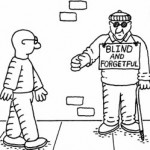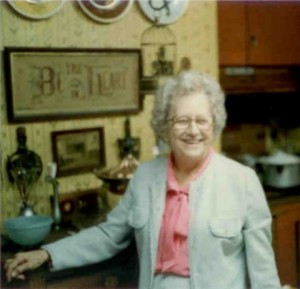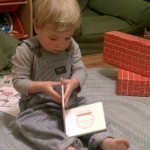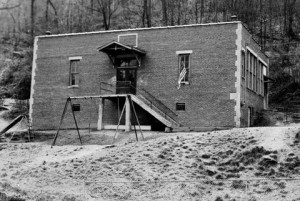
Martin School was a two-room schoolhouse in West Virginia where I grew up. Built in the early 1900’s by my Grandpa Kyle, three generations passed through its doors before it was closed in 1968 and was used to store something far less important than young minds.
I attended Martin for first and second grades. My aunt, Mrs. Jeannette Hale was the first grade teacher and the principal. Mrs. Phelan taught second grade across the hall. My favorite employee come lunchtime was Mrs. Gregory, the cook. Her tiny kitchen, about the size of a small closet, was at the end of the short hall between the two rooms.
She cooked a hot lunch every day which she served at our seats in the classroom, pulling the pastel plastic trays into our room on an old squeaky rolling cart, four trays at a time. The menu varied but her personal best was tomato soup, grilled peanut butter sandwiches (squishy white buttery bread, of course) and chocolate cake with milk chocolate icing, warm from the oven and made from scratch.
Each room had a cloakroom at the back. Only about two feet deep, it had a peg for each child’s coat and a small wooden shelf underneath for boots in the winter. It didn’t have a door but a calico curtain that gathered on a rod across the entire wall of wraps and shoes.
Sometimes if a person talked too much or too loud during subtraction, Mrs. Hale would send you behind that curtain to stand until you could “regain your composure.” I wasn’t sure what composure was but I didn’t have it in the classroom and had many visits behind the curtain. I would always make sure to stand close enough to the curtain so that my nose and shoulders and knees made the outline of my body on the classroom side, just in case anyone forgot I was there.
The curtain always felt slightly damp and smelled like the old string mop that leaned in the corner of our basement laundry room. I could hear my aunt’s crackly voice as she slid the chalk across the blackboard. I always hated it when I knew the answer to her subtraction question and Charlotte Legg was saying eleven take away five was four, for God’s sake. But curtain standers were never allowed to participate.
When my mother, now 88, attended Martin is had six grades divided between the two rooms. She also had her aunt, Ina Kyle, as her first grade teacher. When my sister, who is six years older, went to Martin, there were three grades. Martin had five grades in those two rooms when my brother, nine years older, went there. He only stayed for four years, though. He skipped second grade, perhaps to get away from my aunt. She was always harder on the nieces and nephews, probably for fear of showing favoritism. If she didn’t send you behind the curtain, she would shake you until you were sure you could hear your brains rattle. I had a habit of twirling my shoe with my toe in the heel. Aunt Jeannette stopped that by taping my shoe to my foot and my foot to the floor. At least taped down, she couldn’t send me to the cloak closet.
Warm, home made lunches, the sounds and smells of chalk, crumbly gum erasers, fat yellow lead pencils and the comfort of family, recall a time of childhood and innocence and make attending Martin School one of my sweetest memories.
But the true magic of Martin School reached far beyond its two classrooms. The playhouse under the front steps had an earth floor and cement walls. Old quilts divided the rooms. The kitchen stove was made of red bricks, no doubt left over from when the school house was built several decades before. The small playground in front was not covered in gravel but cinders, a by product of the state’s main industry, coal. The simple swing set had two regular and one trapeze style swing, three feet off the ground, and later a multi-tiered metal jungle gym.
The real playground though was the forest covering the hill behind the school. Some trees had Indian markings, large white knobs that stuck out like eyes, peering down as children played hide and seek behind the trunks. But the best trees were the ones closest to the back of the schoolhouse. They had thick woody vines that hung from their branches. The bravest swingers would grab a vine, take a running start, jump off the hill and cross the small drop off that separated the hill from the back of the school. The most expert of swingers could meet the school with their feet and push off with enough force to land back at the base of the tree. Most of us, though, let go mid-swing and landed in the mixture of moss and dead leaves at the bottom of the shallow ravine.
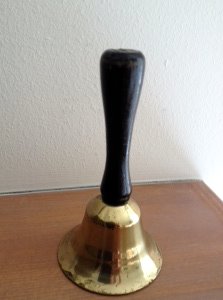
The only rule of the playground was to stay within earshot of the sound of the big brass bell with the long black handle that Aunt Jeannette rang on the front porch when recess was over. We all remembered the day Mike Means walked up that hill and disappeared over its crest. He never came back to school. Some kids said he ran away from school or maybe home. Even Aunt Jeannette didn’t know for sure what became of him. I suspect he had failed enough grades he was old enough to drop out, but we were all more careful to stay together in the woods after that.
At the end of recess, after my aunt rang the bell, Mrs. Gregory would step out onto the front steps and pass out a snack as we filed by to return to our rooms. Sometimes it was salted cabbage, sliced, served raw and icy cold from a huge stainless steel bowl she held perched on her hip. She always wore a cotton printed apron with a bib and lace trim. If you complimented the color or style, she would smile her big gap-toothed smile and say she had made it herself.
Aunt Jeannette, Mrs. Gregory, Mrs. Phelan and Martin School are all gone now. But the lessons they taught, the love of nature they inspired, the magic they created still live in my heart and the hearts of every student who attended that rare and precious school.
As for lessons learned, maybe if I had taped my foot to the floor, it wouldn’t have taken me two days to write this post.

